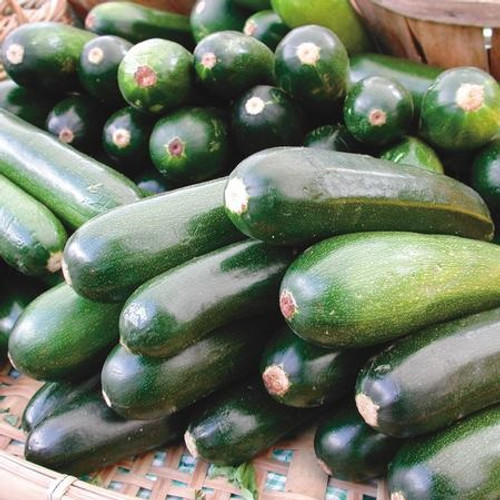A powerhouse of a squash, Emerald Delight supplies a bumper crop of dark green fruit throughout the summer. The open plant habit makes harvesting the tender fruit a breeze, and the mild flavor lends itself to uncountable summer dishes. Vigorous, disease resistant plants performed well in our trials at a time in the season when other zucchinis had already fizzled out. PM, WMV 2, ZYMV.
Soil Temp for Germ 65–85°F
Seed Depth 1–1 ½"
Seed Spacing 3–4/hill
Days to Emergence 5–10
Thin Plants to 1–2/hill
Row Spacing 3–6'
Fertilizer Needs Medium
Minimum Germination 75%
Seeds per Gram See below
Seed Life 3–4 years
Cucurbita spp. In the diverse family of squash are true nutritional powerhouses, encompassing a wide array of forms, flavors, colorations, and culinary applications. Squash are rich in the carotenoids necessary for vitamin A production and boast a wide complement of amino acids. While starchy, most of the carbohydrates in the fruit come from special polysaccharides, pectins, which have exhibited strong antioxidant, anti-inflammatory, and anti-diabetic, insulin-regulating properties.
Days to maturity are from date of direct seeding.
Culture
• Fertile, well-drained soil gives best results
• Squash is a warm season crop, avoid planting too early; raised beds and plastic mulch help keep roots warm
• Squash are monoecious (bearing separate male and female flowers on the same plant) and require insect pollination
• Poor fruit set is often the result of inadequate pollination; plant bee attractant flowers
Direct Sowing
• Plant after frost danger when soil warms to 65°F
• Work in shovelful of compost and 1/2 cup TSC's Complete fertilizer into hill
• Keep soil evenly moist but not wet as too much moisture causes seed to rot
• Bush varieties: sow 3-4 feet apart
• Vining varieties: sow 4-6 feet apart
Transplanting
• Start indoors 3-4 weeks prior to anticipated transplant date in 4 inch pots
• Work in shovelful of compost and 1/2 cup TSC's Complete fertilizer into hill
• Transplant carefully as to not disturb roots
Insects & Diseases
• Common insects: Spotted and striped cucumber beetles, vine borers and squash bugs
• Insect control: Row covers and/or apply Pyrethrin
• Moschata species are resistant to vine borer
• Common diseases: See chart below; diseases vary by region
• Disease prevention: 3-4 year crop rotation, and fungicide applications
Harvest & Storage
• Summer squash: Harvest regularly when fruits are young to keep plants productive
• Winter squash: Leave on vine until fully mature, rinds should be firm
• When winter squash is mature cut stem leaving 2-4 inches remaining, gently wash in sanitizing solution; 10 parts water to 1 part bleach
• For best results move winter squash to a warm dry area 80-90°F to cure; see each type (below) for curing requirements
• Store winter squash at 50-60°F with 50-75% relative humidity and good air circulation
Curing Requirements
• Acorn: Curing not required; Stores 2-3 months
• Buttercup: Cure 10-14 days; Store 1-2 months for best flavor; Will keep 4-6 months
• Butternut: Cure 10-14 days; Store 1-2 months for best flavor; Will keep 4-6 months
• Delicata: Curing not required; Stores 2-3 months
• Hubbard: Cure 10-14 days; Store 1-2 months for best flavor; Will keep 4-6 months
• Kabocha: Cure 10–14 days; Store 1–2 months for best flavor; Will keep 4–6 months
• Mini-Hubbard: Curing not required; Stores 2-3 months
• Spaghetti: Curing not required; Stores 2-3 months
Seeds per gram
• Acorn, Butternut, & Delicata: 9-16
• Buttercup & Hubbard: 3-7
• Green Summer: 4-11
• Kabocha: 5–7
• Spaghetti: 4-7
• Patty Pan: 7-10
• Yellow Summer: 7-15
• Zucchini: 5-8
KEY TO SQUASH DISEASE RESISTANCE AND TOLERANCE
HR indicates high resistance.
IR indicates intermediate resistance.
CMV | Cucumber Mosaic Virus
PM | Powdery Mildew
PRV | Papaya Ringspot Virus
WMV* | Watermelon Mosaic Virus
ZYMV | Zucchini Yellow Mosaic Virus
* Numbers indicate specific disease race.











